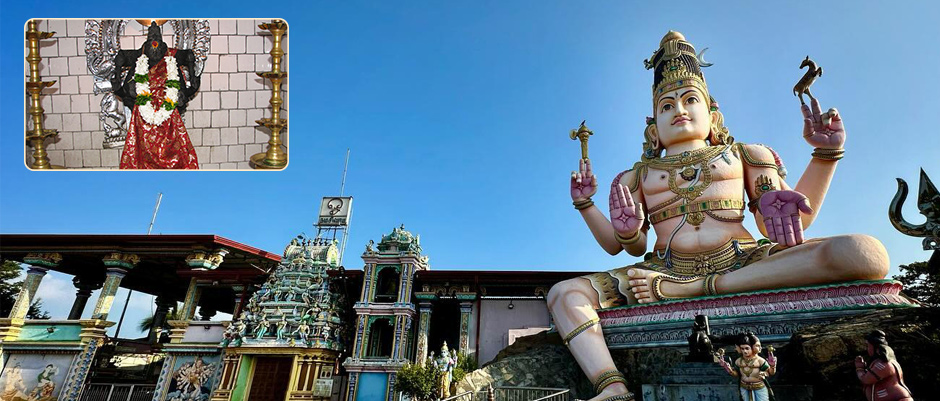
Shankari Devi Shakti Peetham
Shankari Devi Shakti Peetham – The Divine Presence in Trincomalee, Sri Lanka
Along the serene eastern coastline of Sri Lanka, perched high above the sapphire waves, rises the sacred abode of Shankari Devi — a temple that whispers ancient devotion into the ocean breeze. This ancient and revered temple, also known as Koneswaram Temple or Thirukoneswaram, is a sacred abode where Devi Shakti is believed to have graced the earth. Devotees from across Bharat and the world consider it a vital spiritual destination.
A Shrine of Lord Shiva and Goddess Shakti
Thirukoneswaram is not just a temple; it is a sanctified site where Lord Shiva and Goddess Shakti are worshipped together. While the temple is primarily a Shaivite shrine, it also holds deep reverence as one of the 18 Shakti Peethas, where it is believed the groin of Sati Devi fell during Lord Shiva’s tandava with her celestial body. This makes the temple sacred to both Shaktas and Shaivites alike.
The Ancient Port Town of Trincomalee
Trincomalee, called Thirukonamalai in Tamil – meaning “Sacred Eastern Hill” – has been an important natural harbor since ancient times. Traders and explorers like Marco Polo and Ptolemy noted its strategic and mystical charm. With its deep blue waters and coastal hills, the area has long been known for its volcanic activity, particularly around the Kanniya Hot Springs, adding to its mystical aura.
A Temple Rooted in History
The temple has a long-standing history dating back thousands of years, even before the arrival of Prince Vijaya, the legendary founder of the Sinhalese race. South Indian dynasties like the Cholas, Pallavas, and Pandyas made offerings here, and several stone inscriptions in Tamil and Sanskrit validate this sacred connection. The temple also finds mention in the Tevaram hymns of Nayanmar Sundarar, proof of its wide recognition in the Bhakti era.
Ravana and the Divine Mansion of Shankari Devi – A Sacred Legend
A beautiful legend speaks of the time when Goddess Parvati requested Lord Shiva for a splendid palace to live in, surrounded by divine beauty. The celestial architect Vishwakarma built an exquisite mansion atop the eastern cliffs of Lanka. The couple was so pleased with the palace that they chose to perform the Grihapravesha (housewarming ritual) there. Searching for a worthy Brahmana to conduct the sacred rites, they were drawn by the powerful chanting of Ravana, who was deep in penance invoking Lord Shiva.
Impressed by his devotion, Shiva blessed him, and Parvati chose Ravana to perform the ceremony. As dakshina (offering), Ravana humbly requested the palace itself. Parvati, seeing the hand of destiny at play, granted him the wish. However, she laid one condition – she would remain in Lanka only so long as he upheld dharma.
When Ravana kidnapped Sita Devi, ignoring the advice of Shankari Devi to return her to Rama, the Devi left the island in disappointment. As Shankari Devi withdrew her presence, the land of Lanka slowly slipped into unrest and decline, losing the divine grace that once nourished its soul. Only after the coronation of Vibhishana did she agree to return and bless the land once more.
Destruction and Revival
In 1622, during the Portuguese colonization of Sri Lanka, the original temple – referred to as the "Temple of a Thousand Pillars" – was demolished, and its sacred materials were used to build a fort. The surviving statues were hidden in a well to protect them from destruction. Over time, the temple faded into ruins.
Yet, after Sri Lanka gained independence, the temple was reconstructed in 1952 by local Tamil Hindus. Though much smaller than its former glory, the spiritual energy of Shankari Devi continues to pervade the sanctum. Pilgrims from across India and Sri Lanka gather here annually for the grand festival held in Her honor.
Sacred Literature and Prophecy
A poetic Tamil text titled "Thirukonasala Vaipavam" by V. Akilesapillai narrates the temple's deep spiritual and historical significance. An ancient stone inscription associated with King Kulakottan carries a prophecy – foretelling the arrival of westerners and their rule for five centuries, after which the land would return to its native rulers. This prophetic line resonates even today as a reminder of cultural resilience.
A Shakti Peetham of Eternal Presence
Even today, the cliff on which the temple stands is believed by devotees to be part of Mount Kailasha itself. The powerful presence of Shankari Devi is said to bless all those who visit with strength, protection, and spiritual clarity. As a Shakti Peetha, the vibrations here are beyond the reach of words – only felt deeply in the soul.
Timings: The temple opens 6:00 AM and closes at 6:00 PM
